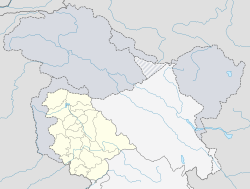Uri (India)
| Uri | |
|---|---|
| Town | |
| Location in Jammu and Kashmir, India | |
| Coordinates: 34°5′10″N 74°2′0″E / 34.08611°N 74.03333°ECoordinates: 34°5′10″N 74°2′0″E / 34.08611°N 74.03333°E | |
| Country |
|
| State | Jammu and Kashmir |
| District | Baramulla |
| Government | |
| • Type | Tehsil |
| Population (2011) | |
| • Total | 9,366 |
| Sex ratio 6,674/2,692 ♂/♀ | |
| Languages | |
| • Official | Urdu |
| Time zone | IST (UTC+5:30) |
| PIN | 193123 |
| Telephone code | 01956 |
| Vehicle registration | JK 05 |
| Sex ratio | 1.13 |
| Literacy | 83% |
| Website | www |
Uri (Urdu: اوڑی) is a town and a tehsil in the Baramulla district, in the Indian-administered state of Jammu and Kashmir. Uri is located on the left bank of the Jhelum River, about 10 kilometres (6.2 mi) east of the Line of Control with Pakistan.
Hari Singh Nalwa (r. 1820–1823), the Sikh commander-cum-administrator of Maharaja Ranjit Singh, built the fort of Uri.
Following the First Anglo-Sikh War (1845–1846) and the Treaty of Amritsar (1846), Raja Gulab Singh was proclaimed the Maharaja of Jammu and Kashmir, acquiring all the lands between the Ravi River and the Indus. Uri became a tehsil in the Muzaffarabad district of the Kashmir province.
On 22 October 1947, the tribal invasion led to the fall of Muzaffarabad and Uri to the Pashtun tribes from Pakistan. The raiders then halted at Baramulla. Following the accession of the Maharaja to India on 26 October, India air lifted troops to the Kashmir Valley, who retook Baramulla and Uri by mid-November. The Indian government attached utmost importance to the defence of Uri. Muzaffarabad, on the other hand, came under Pakistani control and became the capital of Azad Kashmir. The tehsil of Uri was subsequently merged into the Baramulla district.
...
Wikipedia


